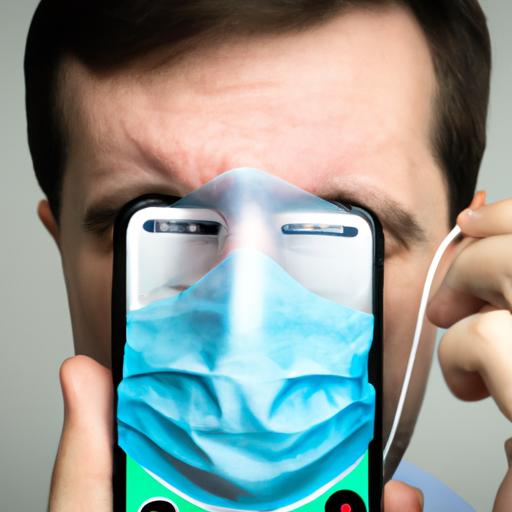Introduction
In today’s digital age, securing our personal devices has become paramount. Face ID, an innovative biometric authentication feature introduced by Apple, has revolutionized the way we unlock our iPhones. However, the global pandemic has presented a new challenge – wearing masks. As masks have become an essential part of our daily lives, it’s crucial to adapt Face ID to accommodate this change. In this article, I will guide you through the process of setting up Face ID with a mask, ensuring enhanced security and convenience even in these challenging times.
Importance of Face ID
Face ID is more than just a convenient unlocking method. It provides a seamless experience by utilizing advanced facial recognition technology, offering a secure way to access your device, authorize payments, and protect sensitive information. By recognizing unique facial features, Face ID ensures that only authorized individuals can access your iPhone, safeguarding your privacy and providing peace of mind.
Challenges faced with wearing masks
With the widespread use of masks, Face ID encounters difficulties in recognizing the face and unlocking the device. Masks cover a significant portion of the face, obstructing the crucial facial data that Face ID relies upon. This can lead to frustration and inconvenience, requiring users to resort to entering passcodes manually. However, there is a solution – setting up Face ID with a mask.
Need for setting up Face ID with mask
Setting up Face ID with a mask is essential to maintain the convenience and security provided by this feature. By calibrating Face ID to recognize your face with a mask on, you can seamlessly unlock your iPhone without compromising on safety. This allows you to continue utilizing the benefits of Face ID while adhering to necessary safety measures. In the following sections, I will walk you through the step-by-step process of setting up Face ID with a mask, ensuring a hassle-free experience even in mask-wearing situations.
Stay tuned for Section II, where we will delve into a comprehensive understanding of Face ID and its benefits. By the end of this article, you will be equipped with the knowledge to optimize Face ID for mask usage, bringing convenience and security to your fingertips.
Understanding Face ID
Explanation of Face ID technology
Face ID utilizes a sophisticated blend of hardware and software components to provide robust facial recognition. Equipped with a TrueDepth camera system, it captures accurate depth information by projecting and analyzing over 30,000 invisible infrared dots on your face. This data is then transformed into a mathematical representation, stored securely within the device’s Secure Enclave.
The neural engine, powered by Apple’s advanced machine learning algorithms, constantly adapts to changes in your appearance, ensuring reliable recognition. It can differentiate between real faces and photos, preventing unauthorized access. With its state-of-the-art technology, Face ID sets a new standard for secure and effortless authentication.
Benefits of using Face ID for device security
Face ID offers numerous advantages over traditional passcode-based authentication. Firstly, it eliminates the need for remembering and entering complex passcodes, saving you time and effort. Just a quick glance at your iPhone is all it takes to unlock it and access your apps, messages, and personal data.
Moreover, Face ID enhances security by providing a higher level of protection. Unlike passcodes that can be forgotten, shared, or compromised, your face is unique and cannot be easily replicated. This ensures that only you can unlock your device and authorize sensitive actions like Apple Pay transactions or password-protected applications.
Limitations of Face ID with mask usage
While Face ID is highly reliable and secure, it does face limitations when used with masks. The TrueDepth camera system relies on capturing the entire face to create an accurate facial map for recognition. However, masks cover a significant portion of the face, making it challenging for Face ID to capture essential data points. This can result in occasional failures or delays in unlocking your device.
However, Apple has acknowledged this issue and introduced a solution to help users adapt to the mask-wearing scenario. By following the steps outlined in the upcoming sections, you can optimize Face ID to recognize your face even when wearing a mask, mitigating the limitations and ensuring a smooth user experience.
In the next section, we will dive into the step-by-step process of setting up Face ID with a mask, allowing you to unlock your iPhone effortlessly while keeping your safety a top priority.
Steps to Set Up Face ID with Mask
As we adapt to the new normal of wearing masks, it’s crucial to configure Face ID to recognize your face even when partially covered. Follow these simple steps to set up Face ID with a mask, ensuring seamless unlocking of your iPhone while maintaining security.
A. Ensure iPhone compatibility
Before proceeding with the setup, ensure that your iPhone model supports Face ID and is running the latest iOS version. Face ID is available on iPhone X and later models. To check your device compatibility, go to Settings > Face ID & Passcode. If Face ID is listed, you’re good to go.
B. Preparing your face for Face ID
For optimal Face ID performance, it’s essential to prepare your face for enrollment. Find a well-lit area and hold your iPhone at a comfortable distance, ensuring your face is fully visible. Remove any accessories like glasses or hats that may obstruct the view of your face. It’s important to note that you should wear your mask during this preparation phase to train Face ID with its presence.
C. Enrolling Face ID data with mask on
Now it’s time to enroll your face with a mask on. Open the Settings app on your iPhone and navigate to Face ID & Passcode. Enter your passcode if prompted. Tap on “Set Up Face ID” and follow the on-screen instructions. Position your face within the frame, making sure your mask is securely worn. Move your head in a circular motion to allow Face ID to capture your face from different angles. Repeat this process a few times to enhance accuracy.
D. Testing Face ID functionality with mask
Once you’ve successfully enrolled your face with a mask, it’s crucial to test the functionality to ensure it works seamlessly. Lock your iPhone and put on your mask. Gently raise the device to your face, and Face ID should recognize you even with the mask on. If it doesn’t unlock, make sure your mask is properly worn and try again. It’s recommended to test Face ID from different angles and lighting conditions to verify its reliability.
By following these steps, you can optimize Face ID to work effectively with a mask, providing you with a secure and convenient unlocking experience. In the next section, we will explore troubleshooting tips to overcome common issues encountered when using Face ID with a mask.
Section IV: Troubleshooting Face ID with Mask
Common Issues Faced with Face ID and Masks
While setting up Face ID with a mask can enhance your device’s security, it’s important to address the common challenges that may arise. Here are some issues you may encounter when using Face ID with a mask:
- Recognition Failure: Face ID may struggle to recognize your face with a mask on, leading to repeated failed attempts at unlocking your device.
- Slow Authentication: The process of authentication might take longer than usual due to the additional step of Face ID analyzing your face with a mask.
- Inconsistent Performance: Face ID performance may vary depending on the type of mask you wear, the fit, and the lighting conditions.
Tips to Improve Face ID Accuracy with Mask
Fortunately, there are several tips you can follow to enhance Face ID accuracy and overcome these challenges:
1. Positioning: When unlocking your device, ensure your mask covers only the necessary areas, such as the nose and mouth, while leaving the rest of your face visible to Face ID. Adjust the mask to sit comfortably without obstructing your face.
2. Register Alternate Appearance: Face ID allows you to register an alternate appearance. Consider enrolling a separate Face ID data while wearing a mask to improve recognition when you have it on.
3. Cleanliness: Keep your iPhone and the TrueDepth camera clean, as dirt, sweat, or smudges on the camera module can affect Face ID accuracy. Regularly wipe the camera lens with a soft cloth.
4. Well-lit Environment: Ensure you are in a well-lit environment when setting up Face ID or unlocking your device. Sufficient lighting helps Face ID capture accurate facial data even with a mask.
Resetting Face ID Settings if Needed
In some cases, you might encounter persistent issues with Face ID and masks. If troubleshooting tips do not yield satisfactory results, you can consider resetting Face ID settings as a last resort. To do this, follow these steps:
- Go to “Settings” on your iPhone.
- Navigate to “Face ID & Passcode.”
- Select “Reset Face ID” and confirm your action.
- Set up Face ID again, following the on-screen instructions.
Resetting Face ID settings can help resolve any underlying issues and provide a fresh start for setting up Face ID with a mask.
Continue reading Section V, where we explore alternative unlocking methods for situations when Face ID with a mask becomes impractical. By optimizing Face ID with these troubleshooting tips, you can ensure a smoother and more reliable experience.
Alternative Unlocking Methods with Mask
While setting up Face ID with a mask is an effective solution, there are alternative unlocking methods that can provide a seamless experience even when wearing a mask. Let’s explore these options:
Using a passcode as a backup option
When Face ID encounters difficulties recognizing your face with a mask, having a passcode as a backup option can be incredibly convenient. By simply entering your passcode, you can bypass any issues with Face ID and quickly access your iPhone. It’s important to choose a passcode that is secure yet easy to remember, ensuring a smooth transition between Face ID and passcode usage.
Utilizing Apple Watch for seamless unlocking
If you own an Apple Watch, you can take advantage of its seamless integration with Face ID to unlock your iPhone effortlessly, even when wearing a mask. With the “Unlock with Apple Watch” feature enabled, your iPhone will authenticate your face using the Apple Watch’s proximity and unlock the device, bypassing the need to remove your mask or enter a passcode. This convenient feature ensures a hassle-free experience while maintaining the security provided by Face ID.
Exploring third-party apps for mask-friendly authentication
In addition to the built-in unlocking methods, there are third-party apps available that offer mask-friendly authentication options. These apps utilize alternate biometric methods, such as fingerprint recognition or voice authentication, to unlock your device without relying solely on Face ID. By exploring these apps, you can find a method that works best for you and seamlessly unlocks your iPhone while wearing a mask.
By leveraging these alternative unlocking methods, you can ensure a smooth and secure experience when using your iPhone with a mask. Whether it’s using a passcode as a backup, utilizing your Apple Watch, or exploring third-party apps, these options provide flexibility and convenience while maintaining the necessary safety measures.
In the next section, we will address common troubleshooting tips to improve Face ID accuracy with a mask. Stay tuned for valuable insights to enhance your Face ID experience!
Conclusion
Setting up Face ID to work seamlessly with masks is a crucial step in adapting to the new normal while ensuring the security and convenience of your iPhone. By following the outlined steps and troubleshooting tips, you can overcome the challenges posed by mask usage and enjoy the benefits of Face ID even in these unprecedented times.
In this article, we explored the importance of Face ID for device security and the challenges faced when wearing masks. We discussed the need to set up Face ID with a mask and provided a step-by-step guide to help you through the process. Additionally, we explored alternative unlocking methods and highlighted the convenience of using a passcode or an Apple Watch as backup options.
Remember to keep your Face ID settings up to date and follow the best practices for improved accuracy. If you encounter any issues, refer to the troubleshooting tips provided to ensure a smooth experience. With Face ID set up to recognize your face even with a mask on, you can confidently unlock your device and access your information without compromising security.
By adapting to the new normal and leveraging the capabilities of Face ID, you can navigate through your iPhone effortlessly while keeping your personal data secure. Embrace the convenience and peace of mind that Face ID with a mask provides, and stay connected with confidence.
Thank you for joining me on this journey to optimize Face ID for mask usage. Stay safe, stay secure, and enjoy the seamless unlocking experience with Face ID and your trusted mask companion.



